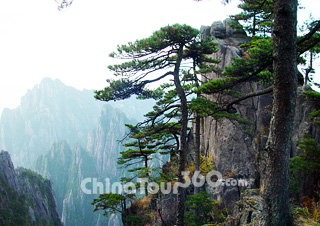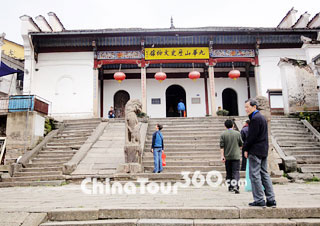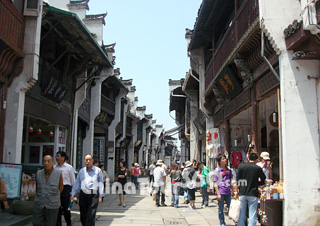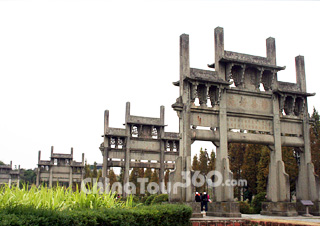 Anhui Mount Huangshan
Anhui Mount Huangshan Jiuhua Mountain, Hefei
Jiuhua Mountain, Hefei Tunxi Ancient Street, Huangshan
Tunxi Ancient Street, Huangshan Tangyue Memorial Archway
Tangyue Memorial Archway Lord Bao Temple, Hefei
Lord Bao Temple, Hefei
Anhui Province, Wan for short, is located in the east of China, bordering on Jiangsu, Jiangxi, Zhejiang, Hubei, Henan and Shandong provinces. The lower streams of Yangtze River and the Huai River flow through it. Anhui covers an area of 139,600 square kilometers (53,899.9 square miles) and has a total population of 59,500,500 (2010 statistics).
The provincial capital of Anhui is Hefei city. With a history of over 2,000 years, Hefei is also the political, economic, cultural, business and trade center of the province. The city of Huangshan is located in southernmost Anhui and earns its fame from nearby Mount Huangshan and the unique Anhui-style buildings of the city itself. Wuhu is the second political, economic, cultural, and transportation center in the province. The famous Chery Automobile Company is located here. Ma’anshan City is very close to Nanjing, and has a 4-A level tourist attraction, the Caishiji Scenic Area. Anqing City was the previous capital of Anhui and is now an important port city along the Yangtze River. The Tianzhu Mountain Scenic Area in Anqing enjoys the same fame as Huangshan Mountain. In Chizhou, another port city of the Yangtze River are the Jiuhua Mountain Scenic Area and Xinghua Village Scenic Area.
Anhui is not only rich in remarkable natural beauty but also boasts many historical culture sites. The natural scenery includes Mount Huangshan, Jiuhua Mountain, Langya Mountain, Tianzhu Mountain, Chaohu Lake and Caishiji scenic area. The cultural sites consist of Xidi and Hongcun villages in Yi County, Huizhou Ancient Town and Huashan Mystery Cave in Huangshan City, and Xinghua Village Scenic Area in Chizhou City.
Anhui is situated at the transitional region between subtropical and warm temperate zones. It has a humid mild climate with four distinct seasons. The average annual temperature is 13°C - 16°C (55.4°F – 60.8°F). Generally, one may visit Anhui all year round, but each attraction takes on a different aspect according to the season. Mount Huangshan and Jiuhua Mountain are good exemples.
Usually, the best time to climb Mount Huangshan is between April and November. Sunny days are a good time to appreciate the twisted pines clinging to the bare rocks. But on cloudy days, the cloud sea shrouds the mountain in mystery, revealing tantalizing glimpses of unearthly beauty. On rainy days, waterfalls and fountains vibrate with life, and if it snows the mountain wears a white and crystalline coat; on windy days, the wind plays beautiful, natural songs as it races through the valleys and meanders among the pines. However, most visitors believe that Mount Huangshan is most beautiful in winters, especially when it snows. So December to February is the best time to see the snowy aspect of Mount Huangshan.
The Jiuhua Mountain is one of the four famous Buddhist mountains in China, along with the Wutai, Emei and Putuo mountains. It is suitable to visit it all the year round if you are interested in the temples and Buddhist culture. But the best time to appreciate the natural scenery is spring and autumn (March to May and September to November).
Day One: Cloud Valley Temple → Swan Range → Shixin Peak (appreciating pines) → North Sea Scenic Area (appreciating peaks) → West Sea Scenic Area (watching sun set) → Flying Rock → Bright Summit (watching cloud sea) → stay in the hotels in North Sea Scenic Area for the night
Day Two: North Sea → Bright Summit → Sky Sea Scenic Area (watching sun rise) → Lotus Valley → Jade Screen Tower Scenic Area (appreciating the peaks and pines) → Tiandu Peak → Banshan Temple → Lima Peak → Merciful Light Pavilion → Tunxi
China Highlights Tour with Huangshan:
13-Day of Shanghai - Huangshan - Suzhou - Zhouzhuang - Suzhou - Hangzhou - Beijing







